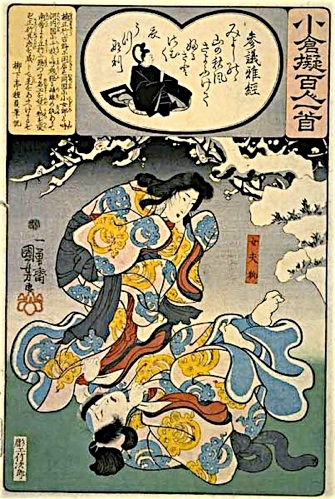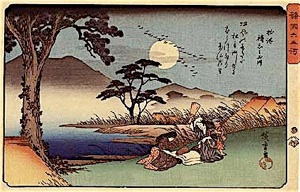参議雅経


み吉野の
山の秋風
さよふけて
ふるさと寒く
衣うつなり
さんぎまさつね
みよしのの
やまのあきかぜ
さよふけて
ふるさとさむく
ころもうつなり
Fujiwara no Masatsune
From fair Yoshino’s mountains
The autum wind blows
Cold over the old village
In the falling night
With the sound of pounding cloth.
Fujiwara no Masatsune (1170 - 1221), also called Sangi Masatsune (Counsellor) or Asukai Masatsune, son of Yoritsune, was the founder of the Asukai poetry and calligraphy salon. His personal poetry collection is the Asukai Shu. He belongs to the Thirty-Six Immortal Poets and was one of the editors of the Shin Kokinshu. He has 134 poems in imperial collections.
This poem refers to a poem by Korenori (poet 31) in the Kokinshu:
みよしのの山の白雪つもるらしふるさとさむくなりまさるなり
In fair Yoshino’s mountains
The white snow
Seems to pile up
And the old village
Ever growing colder.
The headnote to this poem in the Shin Kokinshu says that it was composed on the theme of ‘fulling cloth’. By striking the cloth on a fulling block, women removed wrinkles and restored the sheen of clothing. The sound of the fulling block is among the unfamiliar sounds Genji hears in the chapter Yugao, ‘Evening Faces’, in the Genji Monogatari. Traditionally, women pounded silk with wooden mallets. It was done in the evenings. The sound evoked the mood of long, solitary autumn nights and was often used as an image of loneliness and longing in classical Japanese poetry.
Kuniyoshi


Unfortunately, there is no known Hokusai woodcut for this poem. The Kuniyoshi print seems to illustrate the pounding of cloth in a different way, with the direct object still being in the clothing.
There is a play with words in fuku and furusato (birthplace, old village, native place), fuku (to blow) and furu (to fall, like rain or snow) being closely related.
Some translate furusato as ‘former capital’, which is indeed one of the dictionary explanations, but for all I know, Yoshino only became the temporary capital under emperor Godaigo (reigned 1318-1339) when the above poems were already ancient. At least the books I have consulted do not mention Yoshino as having been one of the earliest capitals. Maybe they consider the first capital, Asuka, up north, to have included the whole area around Yoshino, or they have the Yamato region in mind, the distance from Asuka to Yoshino being about 10 km.

Fulling cloth on a woodblock

Hiroshige - Settsu toi no Tamagawa
